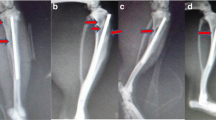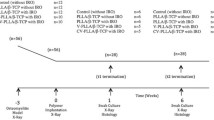Abstract
Bisphosphonates are systemic drugs. There is limited knowledge about their effects when applied locally and in osteomyelitis treatment. A prospective longitudinal randomised controlled study was designed in rat tibia to test the efficacy of local or systemically administered bisphosphonates for controlling the osteolytic reactions and possible effects on local infection control. Tibial osteomyelitis was induced in 72 Wistar albino rats with Staphylococcus aureus ATCC 25923 strain. Débridement was performed on all rats in all groups. No other treatment was given to the control group. Treatment groups received “plain bone grafts”, “vancomycin-loaded bone grafts”, “vancomycin-loaded bone grafts+systemic alendronate”, “alendronate-impregnated bone grafts” and “vancomycin+alendronate-impregnated grafts”. Study results were evaluated by swab cultures, radiology, quantitative computed tomography, dual-energy X-ray absorptiometry (DEXA) and histopathology. S. aureus was eradicated in groups II and IV by the sixth week. Diaphyseal widening, bone deformation, diaphyseal widening and osteolysis scores were significantly lower (p < 0.05), and bone mineral content, density measurements and DEXA scores were significantly higher (p = 0.001) with alendronate administration. Histology revealed marked osteoblastic activity. Local alendronate interfered with local infection control. Even though local alendronate at the given dose has stronger effects, the possible effects on the local inflammatory process needs to be clarified.
Résumé
Les Bisphosphonates sont des médicaments utilisés par voie systémique avec un effet systémique. Nous n’avons aucune connaissance sur leurs effets lorsqu’ils sont utilisés localement, notamment dans le traitement de l’ostéomyélite. Une étude prospective longitudinale randomisée a été réalisée sur le tibia de rat afin de tester l’efficacité de l’administration systémique ou locale des bisphosphonates sur les réactions ostéolytiques et sur de possibles effets sur une infection locale. L’ostéomyélite tibiale a été induite chez 72 rats albinos Wistar avec une inoculation d’un staphylocoque Aureus ATCC 25923. Une mise à plat a été réalisée chez tous les rats, dans tous les groupes. Il n’y a pas eu d’autres traitements dans le groupe contrôle. Les autres groupes ont reçu une greffe osseuse, soit une greffe osseuse imprégnée de vancomycine soit une greffe osseuse imprégnée de vancomycine et avec injection systémique d’alendronate, soit une greffe osseuse imprégnée d’alendronate et enfin une greffe osseuse imprégnée d’alendronate et de vancomycine. Les résultats ont été évalués par cultures bactériologiques, radio, QCT, DEXA et histopathologie. Le staphylocoque doré a été éradiqué dans les groupes II et IV après six semaines. Le gonflement diaphysaire, la déformation osseuse et l’élargissement diaphysaire avec lésions ostéolytiques ont été de façon significative diminués (p < 0.05), de même que la densité minérale osseuse et le score DEXA ont été significativement plus élevés (p = 0.001) ceci grâce à l’administration de l’alendronate. L’examen histologique a mis en évidence une activité ostéoblastique et l’on peut affirmer que l’administration locale d’alendronate a une influence sur une infection locale. Cependant, l’alendronate administré localement peut avoir des effets importants au niveau du processus inflammatoire qu’il faudra étudier secondairement.


Similar content being viewed by others
References
An YH, Friedman RJ (1999) Animal models of orthopaedic prosthetic infections. In: An YH, Friedman RJ (eds) Animal models in orthopaedics research. CRC, Boca Raton, pp 443–457
Aspenberg P, Astrand J (2002) Bone allografts pretreated with a bisphosphonate are not resorbed. Acta Orthop Scand 73(1):20–23
Bragdon CR, Doherty AM, Jasty M, Rubash H, Harris WH (2005) Effect of oral alendronate on net bone ingrowth into canine cementless total hips. J Arthroplasty 20(2):258–263
Buxton TB, Walsh DS, Harvey SB, McPherson JC 3rd, Hartmann JF, Plowman KM (2004) Bisphosphonate-ciprofloxacin bound to Skelite is a prototype for enhancing experimental local antibiotic delivery to injured bone. Br J Surg 91(9):1192–1196
Chan YS, Ueng SW, Wang CJ, Lee SS, Chen CY, Shin CH (2000) Antibiotic-impregnated autogenic cancellous bone grafting is an effective and safe method for the management of small infected tibial defects: a comparison study. J Trauma 48(2):246–255
Chen CE, Ko JY, Pan CC (2005) Results of vancomycin-impregnated cancellous bone grafting for infected tibial nonunion. Arch Orthop Trauma Surg 125(6):369–375
Finley JM (2001) Antibiotic supplementation of bone allografts: a review. J West Soc Periodontol Periodontal Abstr 49(1):5–9
Im GI, Qureshi SA, Kenney J, Rubash HE, Shanbhag AS (2004) Osteoblast proliferation and maturation by bisphosphonates. Biomaterials 25(18):4105–4115
Kajiwara H, Yamaza T, Yoshinari M, Goto T, Iyama S, Atsuta I et al (2005) The bisphosphonate pamidronate on the surface of titanium stimulates bone formation around tibial implants in rats. Biomaterials 26(6):581–587
Korkusuz F, Uchida A, Shinto Y, Inoue K, Ono K (1992) Biomaterial centred chronic osteomyelitis. Turk Med Res J 10:268–292
Korkusuz F, Akin S, Akkus O, Korkusuz P (2000) Assessment of mineral density and atomic content of fracture callus by quantitative computerized tomography. J Orthop Sci 5(3):248–255
Lane JM, Sandhu HS (1987) Current approaches to experimental bone grafting. Orthop Clin North Am 18(2):213–225
Lin JT, Lane JM (2003) Bisphosphonates. J Am Acad Orthop Surg 11(1):1–4
Littlewood-Evans AJ, Hattenberger MR, Luscher C, Patakı A, Zak O, O’Reılly T (1997) Local expression of tumor necrosis factor alpha in an experimental model of acute osteomyelitis in rats. Infect Immun 65(8):3438–3443
Liu SJ, Wen-Neng Ueng S, Lin SS, Chan EC (2002) In vivo release of vancomycin from biodegradable beads. J Biomed Mater Res 63(6):807–813
Mader JT, Stevens CM, Stevens JH et al (2002) Treatment of experimental osteomyelitis with a fibrin sealant antibiotic implant. Clin Orthop 403:58–72
Norden CW (1988) Lessons learned from animal models of osteomyelitis. Rev Infect Dis 10(1):103–110
Rogers MJ, Gordon S, Benford HL, Coxon FP, Luckman SP, Monkkonen J et al (2000) Cellular and molecular mechanisms of action of bisphosphonates. Cancer 88(12 Suppl):2961–2978
Sansoni P, Passeri G, Fagnoni F, Mohagheghpour N, Snelli G, Brianti V et al (1995) Inhibition of antigen-presenting cell function by alendronate in vitro. J Bone Miner Res 10(11):1719–1725
Shanbhag AS (2006) Use of bisphosphonates to improve the durability of total joint replacements. J Am Acad Orthop Surg 14(4):215–225
Wang X, Shanbhag AS, Rubash HE, Agrawal CM (1999) Short-term effects of bisphosphonates on the biomechanical properties of canine bone. J Biomed Mater Res 44(4):456–460
Witso E, Persen L, Loseth K, Bergh K (1999) Adsorption and release of antibiotics from morselized cancellous bone. In vitro studies of 8 antibiotics. Acta Orthop Scand 70(3):298–304
Witso E, Persen L, Loseth K, Benum P, Bergh K (2000) Cancellous bone as an antibiotic carrier. Acta Orthop Scand 71(1):80–84
Witso E, Persen L, Benum P, Bergh K (2002) Release of netilmicin and vancomycin from cancellous bone. Acta Orthop Scand 73(2):199–205
Wixson SK, Smiler KL (1998) Anesthesia and analgesia in rodents. In: Kohn DF, Wixson SK, White WJ, Benson GJ (eds) Anesthesia and analgesia in laboratory animals. Academic, San Diego, pp 173–184
Acknowledgement
The authors thank Prof. Dr. M.C. Avunduk, Selcuk University, Faculty of Medicine, Dept. of Pathology for his kind help in histological assessment and Merck Research Laboratories, Merck & Co., Inc, Rathway, NJ, USA for kindly supplying alendronate and financial support for the project. The above-mentioned company was not involved in planning the experiment and did not take part in data collection, analyses, interpretation or writing of the manuscript.
Author information
Authors and Affiliations
Corresponding author
Rights and permissions
About this article
Cite this article
Ozturk, A.M., Tabak, A.Y., Aktekin, C.N. et al. Alendronate enhances antibiotic-impregnated bone grafts in the treatment of osteomyelitis. International Orthopaedics (SICO 32, 821–827 (2008). https://doi.org/10.1007/s00264-007-0396-8
Received:
Revised:
Accepted:
Published:
Issue Date:
DOI: https://doi.org/10.1007/s00264-007-0396-8




